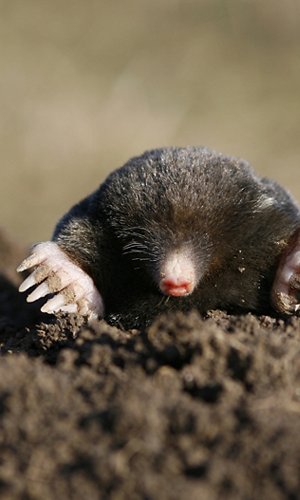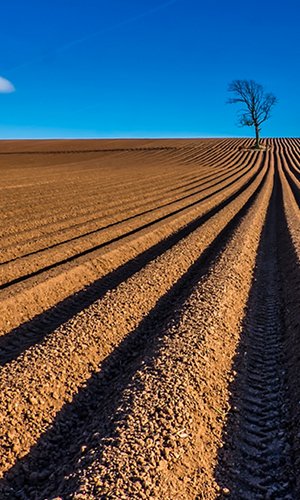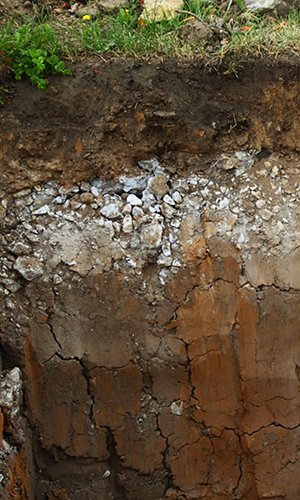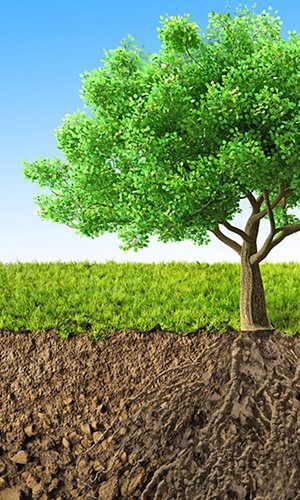The soil is thin layer covering the Earth’s crust, in contact with the atmosphere: its nature and composition depend on an equilibrium between environmental factors of a chemical, physical and biological nature. It represents an important natural resource because it allows the growth of spontaneous vegetation and as a consequence an environment that is rich and varied, where many forms of life live, mainly micro-organisms and insects. Here, thanks to the presence of microflora and microfauna, the nitrogen, carbon and phosphorus cycles are completed. These are fundamental for all living beings. The soil is also a source of nourishment because it allows the growth of agricultural crops and animal farming, furthermore it provides wood that is used by a part of the world population as fuel.
Voice search
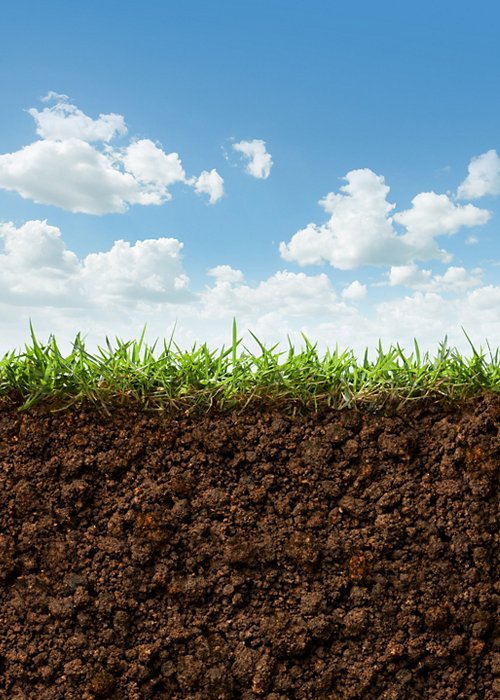
The soil consists of a mixture of solid particles, water and air. Solid particles can be inorganic or organic. The inorganic parts are mainly minerals: silicates, oxides and hydroxides of iron, aluminium, manganese, etc. that, according to their dimension, are classified in skeleton and fine earth, which are then divided into sand, slime and clay. These derive from the alteration of rocks into smaller and incoherent material, which accumulates to form superficial deposits. The deposit of incoherent material can occur in the same place as the rock was disintegrated.
The degradation processes of vegetal residues (leaves, fruits, dry branches or whole plants) and dead animals lead to the creation of organic fractions of the soil. Organic compounds can keep unaltered for long periods (non-humic compounds) or be subject to deep and fast changes in their original chemical structure (humic compounds or humus).
Water and air occupy the free spaces between solid particles (pores), and form a thick and extended network that allows water to move in the ground.
Related topic
Soil structure
When the soil is not removed, the so-called mature soil develops. Paedogenesis is the name of the process that leads to its creation. A mature soil is characterized by a series of layers, called horizons, which differ according to the soil structure and the composition of organic and inorganic parts.
The layers create the soil profile:
- Horizon A: rich in organic components, but lacks clay particles.
- Horizon B: lacks organic material, but is rich in clay particles.
- Horizon C: has particles of real soil and fragments of rock that have not been changed yet.
A natural resource
The soil is an important part of the landscape and contributes to determine the way in which natural vegetation, crops and human settlements are distributed on the territory. But the importance of the soil is mainly related to its double role as a reserve of nutritional elements and water and mechanical support (how would plants be able to stand upright if they did not have the soil to put their roots in?) for vegetation, leading to the creation of forests and protected areas. A direct observation allows us to see the fundamental importance of the soil.
An agricultural and food resource
Agriculture causes a major transformation of the soil and represents the main exploitation of renewable resources (water, soil, flora, fauna, and atmosphere) of our planet. Agriculture is the main productive activity (sometimes the only activity) for many countries, in particular for tropical and subtropical regions. Agriculture uses the soil to produce food (fruits, vegetables, roots, and other parts of plants that represent the daily nutrition for more than nine-tenth of men), fibres and other useful goods.
Read more...
Soil formation is the result of long processes (paedogenesis) that are generally based on the alteration (that is change) of inorganic (minerals and rocks) and organic compounds (plants and dead animals or substances produced by them, like leaves and faeces) that are present in the area, their deposit and the subsequent formation of new minerals and organic molecules. The final composition and structure of a soil depend on the following factors:
• the parent rock (or lithologic matrix), i.e. the original material (rocks, clays, limestones, etc) of the soil;
• the climate, which is considered as the main responsible for the formation and definition of soil characteristics and properties;
• water and temperature, which influence the majority of physical, chemical and biochemical processes that are important for the development of mature;
• soil sun exposure;
• the activity of biotic entities (vegetation, micro and macro fauna e flora);
• the height, defined by land altitude and inclination;
• the length of time, as the different products of change and the definition of soil characteristics occur in different length of time;
• human activity.
Related topic
The action of the organisms
Organisms can contribute to the disintegration of the parent rock: plant roots enter the rock cracks and can produce acid substances that facilitate disintegration; some sea molluscs produce acid substances that dig holes in the rock and use them as a shelter; lichens manage to penetrate into the rock granules with their microscopic layers; some bacteria produce carbon dioxide, ammonia, nitric acid, sulphurous acid …
Many different types of soil
Soil thickness depends on soil inclination. If the land is inclined rock debris do not accumulate on the spot since, due to force of gravity, they roll down. If the land is very steep, the soil is completely absent as you can observe on mountain rocky walls. Climate is the most active factor as far as soil origin is concerned: the most important elements are the intensity and frequency of rain, evaporation, temperature and wind.
Classification
The soil covers approximately a third of the whole Earth’s surface, with a thickness that ranges from tens of metres to a minimum of few centimetres, according to the intensity and duration of the rock changing processes. The factors that are responsible for soil formation create different types of soil in large geographic areas and inside small regions. The soil, in fact, is different in each area of the world: each area has its own climate, rocks and vegetation and, therefore, its own soil, with unique characteristics.
Read more...
Soil is the ‘place’ where materials essential for ecological equilibrium are formed and decompose, but it is also where our food is produced. Unfortunately, it is also the waiting room of a number of environmental problems that begin in it and terminate elsewhere. Nevertheless, studies regarding soil biology (pedobiology), respect to those regarding let’s say, air and water, are still rather slow: why?
The main reason is that the scientist perceives Nature in the same manner as everyone else, which is not always the correct way of understanding it. In other words, to understand Nature well, one must go beyond what one can see (or hear), and understand Nature by using simple reasoning. Let us consider for example our difficulty in imagining the many processes that take place at a microscopic or sub-microscopic level, such as those that occur in the sphere of cells; or the difficulty in adapting our way of perceiving the passing of time to the scale of biological evolution, that is measured in hundreds of millions of years. Well, these limits have represented one of the most important factors in the orientation of scientific research, in some cases with results that were rather negative for our knowledge: which is the case of soil biology.
Related topic
An environment full of life
Even though not much is known about soil organisms, it is certain that soil is not an inert and sterile environment but, on the contrary, it is a dynamic one overflowing with life. The majority of the organisms live within the first metre in depth and, in general, the biological spaces they occupy and their biological activities are on a very small scale. The growth of cultivated plants, for example, depends on the way in which the solid particles of the soil are arranged to allow the formation of spaces with a diameter of about 0.2 mm.
Life produces organic material
The organic part of soil comes from organisms that live over and under its surface. The variety of these organisms and the exorbitant number of substances that they synthesize, that range from simple amino-acids to large natural polymers, such as lignin, explain the great diversity of organic material present in the earth. In the soil not all the remains of vegetable and animal organisms are biodegradable in the same way. A good part of these residues remains practically unchanged for even rather long periods, accumulating in time.
Earth biology
In the soil, the main biological role, in purely quantitative terms, is played by micro-organisms and in fact, researches have been concentrated mainly on fungi and bacteria. However, if it is true that micro-organisms represent the living creatures that are most ‘present’ in the hypogeal environment, it is also true that they alone cannot explain all the ecological phenomena that take place in the soil. For example, knowledge regarding the relations that concern the higher levels of the soil food chains is still rather poor.
Many factors
A mature soil, from the point of view of pedogenesis, can be defined as a layer of sedimentary rock that is inhabited by living organisms. For pedogenesis (a process that is truly never ending because all soils are slowly and continually changing) purposes, the soil is transformed into a tank, with a practically unlimited capacity, containing organisms. The consequent biodiversity has a very high ecologic value that is also very useful for Man.
Hypogeal animals
An initial concept that must be understood before undertaking a digression on the fauna of the soil is that present day knowledge is not sufficient to list with certainty all the types of animals that inhabit this important natural environment. In fact, the data available nowadays regard animals that have already been studied in most of the ecosystems of the planet. But no one can certify that this data is actually complete with all the hypogeal species, because still today many areas of the planet have not been thoroughly explored as far as the biological component resident in the soil is concerned.
Protozoa and Nematodes
Protozoa can be considered unicellular animals (formed by a single cell) that have dimensions ranging between 2 and several hundred µm (remember that 1000 µm = 1 mm). They are extremely abundant and well distributed in the entire thickness of the first centimetres of soil and their geographical distribution covers climates that extend from the warm and dry areas typical of deserts to cold and damp ones typical of the tundra. Flagellates and amoeboidsrepresent the majority of soil protozoa, specially with respect to those very particular biological communities that form close to the roots of plants (rhizosphere).
Annelids and molluscs
It is important to reflect on the fact that, unlike nematodes, annelids are worms with a real coelom and that phylogenetically they occupy a very different position respect to the former. The main representatives of this particular component of soil fauna are the oligochaetes, i.e. common earthworms with a circular cross-section, characterised by very accentuated body metamerism (the repetition of identical anatomical segments along the body’s principal axis) and by a length that often exceeds 10 mm.
Arthropods
Numerically, arthropods certainly represent the major taxonomic group of hypogeal fauna. Moreover, as far as the range of their dimensions is concerned, arthropods that live in the soil detain a relevant record that is supported by the fact that their length extends from a few tens of µm of the most microscopic ticks to several tens of mm of the longer miriapods. Generally speaking, the most relevant group of arthropods can be identified in the above-mentioned ticks, in collembola (wingless insects in the subclass Apterygota), in miriapods and in araneids.
Vertebrates
In soil biology studies, vertebrates have received the importance they deserve only in recent years. The fact that these animals have on average a much greater mobility respect to invertebrates has probably made some of their adaptations to life underground be overshadowed, but nowadays their importance is being rediscovered. In the course of time, biologists realized that even though they were endowed with great ecological flexibility, many vertebrates had very strong connections with the soil environment.
Read more...
The soil is a dynamic system that has reached a balance with the other surrounding elements. Man can compromise it with his activities and behaviour. The urban development of cities, industrial expansion, the creation of infrastructure like railways, roads, bridges, agriculture, modified the use of soil and sometimes determined its degradation. Soil degradation becomes apparent through some phenomena: desertification, erosion of the superficial layer, an unusual increase of salt content (salinization), acidification and the presence of pollutants. Soil pollution is a particularly serious phenomenon since it has repercussions not only on soil productivity, but also on the composition of the water it gets in contact with (especially drinking water and aquifer water) and on the atmosphere. This is why men have to carry out their activities in such a way as to ensure a high environmental quality of the soil, by eliminating the pollution that has been created in the past (recovery activities) and, above all, avoiding to overexploit the soil.
Related topic
Erosion
The word erosion indicates the slow disintegration of the soil due to the action of agents such as the rain, run-off water (rain water that runs on the land surface), and the wind. Erosion is a natural process that depends on several factors like the topographic configuration of the interested area, the soil composition and structure (in particular, its granulometry), the climate (in particular as far as precipitations are concerned), and the state of its vegetation cover.
Salinization
Saline soils form when the water leaves the ground mainly due to evaporation, transpiration, or percolation. This mainly occurs in dry areas, where precipitations are not sufficient to eliminate the salt from the ground. However, salinization is also frequent on irrigated grounds. However, salinization is also frequent on irrigated grounds. If irrigation (which is fundamentally important in dry regions) is not done in a functional way, or with appropriate water, it can provoke an accumulation of salt…
Desertification
Desertification is a complex phenomenon that occurs in all those areas where temperature and humidity do not make it possible for vegetation to growth. Like for many other natural processes, men can have an influence on desertification, sometimes in very negative ways. Fires and the destruction of the savannah near tropical forests in order to create land for cereals and forage cultivation, are some of the worst examples of irreversible destruction of a delicate ecosystem that favours the desert moving forward.
Soil pollution
Among the various air pollutants that act negatively on soil balance there are gaseous compounds of photochemical origin, like ozone and free radicals, sulphur and nitrogen compounds that are responsible for the increase in rain acidity. In particular, acid rains determine a soil pH reduction (acidification), which, for agricultural soil, can be useful as it satisfies the nutritional needs of many crops that tolerate soil acidity.
Sustainable agriculture
As we have seen, the soil is essentially important for human survival. Men have developed agricultural techniques that allow to obtain good productions at limited costs. Sustainable agriculture derives from the integration of traditional agricultural techniques, that use chemical products like fertilizers and phytosanitary products, with low-environmental impact biological techniques that require a deep knowledge of complex interactions between the soil, water, vegetation and animals. Each year 30-80 billion tons of soil are lost due to erosion.
Heavy metals
Heavy metals (cadmium, cobalt, chromium, copper, mercury, manganese, nickel, lead, zinc, molybdenum, tin) are among the main soil pollutants. In fact they are widely spread, highly toxic and persistent, as they stay in the environment for a long time (through the food chain, for example). If these pollutants exceed determined quantities, they provoke damages to those organisms that absorb them. Usually the metal in the soil is absorbed by the plants and transported through their leaves and fruits.
Acid soil
Usually soil acidity is due to the presence of high quantities of hydrogen and aluminium. Although some acid soil derives directly from acid rocks, most of them are formed in areas with lots of rainfalls or farmed areas. In fact, acidification speed depends on the speed by which the majority of nutritional elements leave the soil (because of rain, or after being assimilated by crops, during harvest), leaving room to those elements that provide acidity.
Treatment of polluted soil
Thanks to its absorbing power, its buffer capacity, and its intense biotic activity, the soil is prone to self-treatment, or at least, is able to reduce the negative effects deriving from the presence of pollutants. Of course the soil self-treatment capacity has some limits. If pollution goes over this limit, the soil can lose its “filter” function in an irreversible way, provoking many damages. Differently from the atmosphere and water, which decontaminate quite rapidly, the soil, although it has a high self-treatment capacity thanks to chemical, physical, and biological mechanisms, keeps contaminated for a long period.

